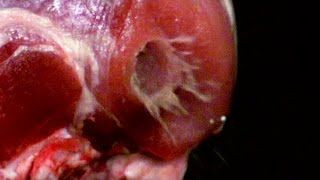What Happens When You Get Shot? Ballistic Gel Shows How Serious A Gunshot Wound Really Is

In 2013, there were more than 84,000 gun-related injuries in the United States alone. Each one of these cases likely caused a great deal of pain, but what actually happens to your body when you get shot? BBC’s Brit Lab used a pig leg and some slow-motion cameras to find out.
The BBC hosts fired a pistol at close range, driving the bullet into the pig’s leg — pig flesh is anatomically similar to humans. It only created a small hole, but it had enough force to penetrate all the way through. This wasn’t enough for the hosts, though, so they turned to ballistic gel, which has the consistency of human tissue, to see what happens on the inside.
As the bullet moved through the gel, they found it left a huge tunnel behind. This happened because the bullet transfers some of its momentum to the gelatin, one of the hosts said. This causes all sorts of internal damage as the energy makes nearby tissue suddenly expand and contract.
To stop a bullet from penetrating the body, police and military forces around the world use Kevlar vests, which are made of a synthetic fiber that’s woven into layers of fabric stronger than steel, and are capable of withstanding a bullet from a pistol shot at short range. Larger, more powerful bullets from rifles can tear right through kevlar vests, though, which is where ceramic tile faceplates come in. Worn only on the front and back of a person, they can stop a rifle bullet. Neither forms of protection are bulletproof, however, only bullet resistant. Shoot a Kevlar vest or faceplate enough times, and the bullet will eventually get through.



























